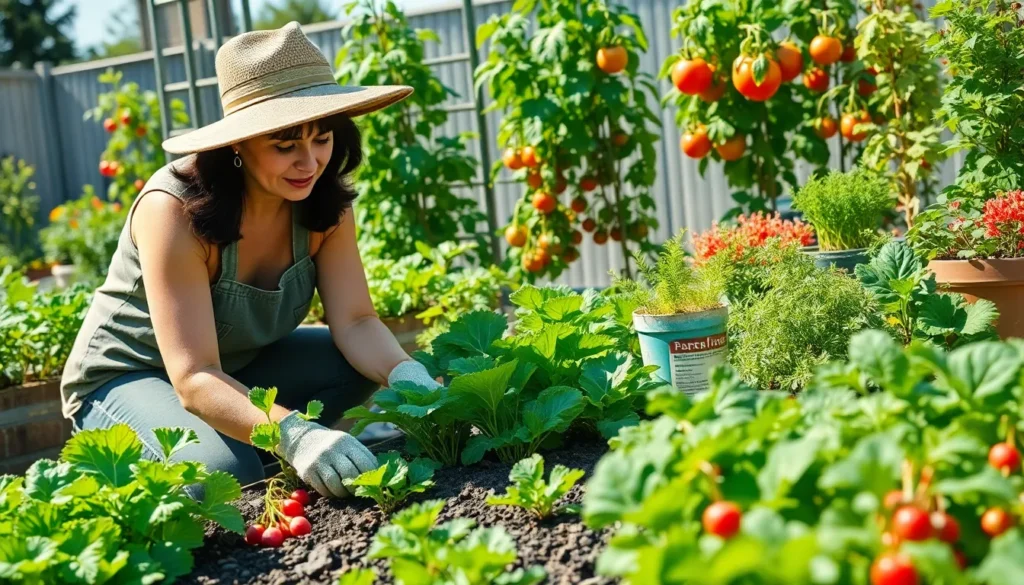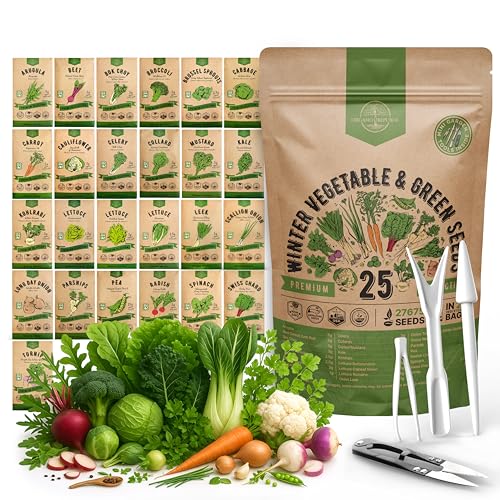Growing your own vegetables isn’t just a hobby – it’s a game-changer that transforms your dinner table and your wallet. We’ve all stared at rising grocery prices and wondered if there’s a better way to put fresh nutritious food on our plates. The answer’s literally in your backyard.
Fresh vegetables from your garden taste better than anything you’ll find in stores. There’s something magical about harvesting sun-warmed tomatoes or crisp lettuce that you’ve nurtured from seed. Plus you’ll know exactly what went into growing your food – no mysterious chemicals or long-distance shipping involved.
Whether you’re working with a sprawling yard or a few containers on your balcony we’re about to share vegetable garden ideas that’ll maximize your harvest and minimize your effort. From space-saving vertical gardens to season-extending techniques these proven strategies will have you growing more food than you ever thought possible.
Start Your Garden With Easy-to-Grow Leafy Greens
Leafy greens offer the perfect starting point for new gardeners because they require minimal space and grow quickly. These nutritious vegetables provide fresh salads and cooking greens within weeks of planting.
Lettuce Varieties for Continuous Harvests
Loose leaf lettuce varieties like Black Seeded Simpson and Red Sails produce tender leaves you can harvest in just 30-45 days. We recommend planting new seeds every 2-3 weeks to maintain a steady supply throughout the growing season.
Romaine lettuce creates crisp hearts perfect for Caesar salads and takes 70-75 days to mature fully. Plant romaine in early spring or fall when temperatures stay between 60-70°F for the best flavor and texture.
Butterhead lettuce varieties such as Boston and Bibb form soft, buttery leaves that add luxury to any meal. These varieties tolerate heat better than romaine but still prefer cooler growing conditions.
Mesclun mixes contain multiple lettuce types and other greens in one packet, giving you diverse flavors and textures. Cut these baby greens when they reach 2-4 inches tall for the most tender leaves.
Spinach for Cool Season Growing
Spring spinach thrives in temperatures between 50-70°F and can be direct seeded 4-6 weeks before the last frost. We suggest choosing bolt resistant varieties like Space and Bloomsdale Long Standing for extended harvests.
Fall spinach often produces better yields than spring crops because plants mature during consistently cool weather. Plant seeds 6-8 weeks before your first expected frost for optimal leaf production.
Baby spinach can be harvested in just 25-30 days when leaves reach 2-3 inches long. This quick turnaround allows for multiple plantings throughout the cool season.
Overwintering spinach survives harsh winters with proper protection like row covers or cold frames. Plant these hardy varieties in late summer for fresh greens during the coldest months.
Kale as a Year Round Staple
Curly kale varieties like Winterbor and Vates handle frost exceptionally well and actually improve in flavor after cold exposure. These tough plants can produce leaves for 8-10 months with proper care and succession planting.
Dinosaur kale features flat, textured leaves that work perfectly for massaged salads and smoothies. This variety, also called Lacinato, matures in 60-70 days and tolerates both heat and cold better than most leafy greens.
Red Russian kale produces purple stemmed leaves with a mild, sweet flavor that appeals to picky eaters. Plant this variety in early spring or late summer for the best leaf quality and longest harvest period.
Baby kale can be harvested as microgreens in 10-14 days or as baby leaves in 25-30 days. We recommend cutting outer leaves regularly to encourage continued growth from the center of the plant.
Plant Fast-Growing Root Vegetables for Quick Results
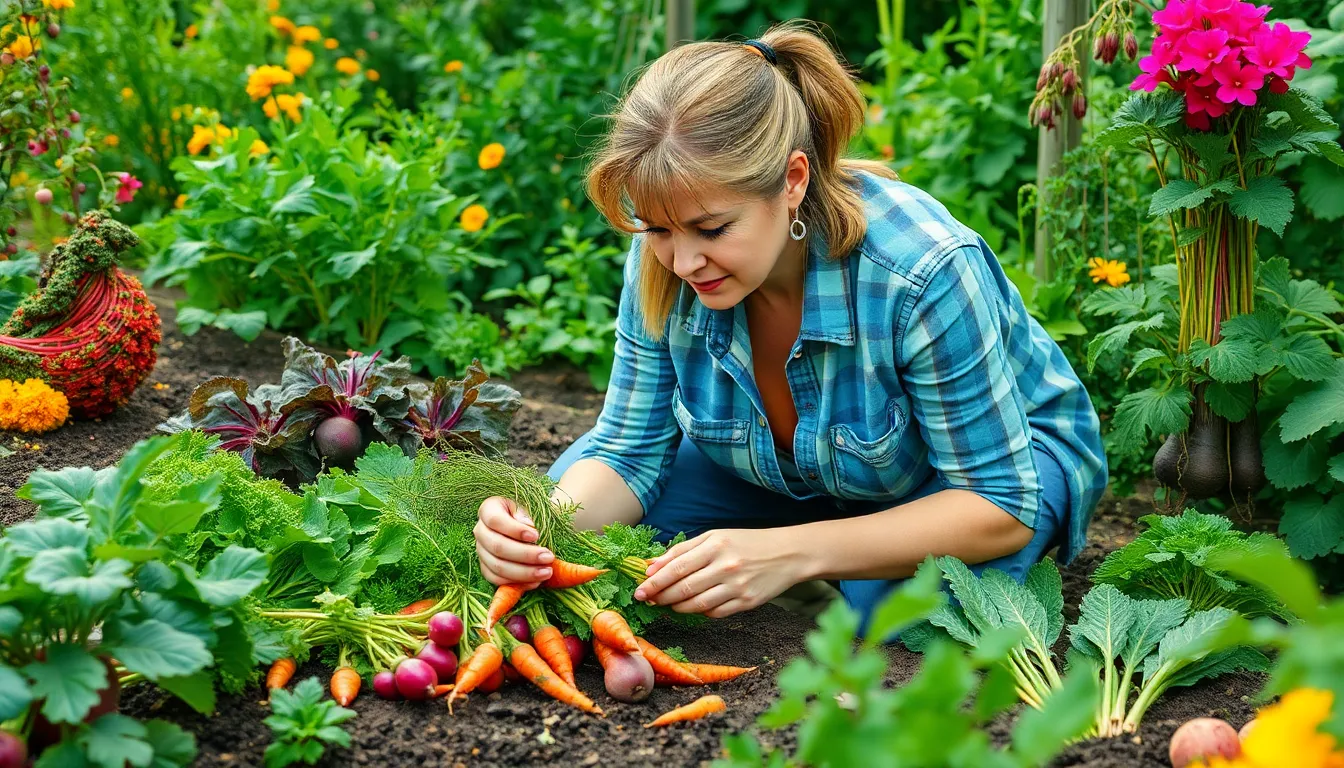
After establishing your leafy greens, we recommend adding fast-growing root vegetables to maximize your garden’s productivity. These underground treasures deliver impressive harvests in just weeks rather than months.
Radishes Ready in 30 Days
Radishes top our list as the fastest-growing vegetables you can plant, ready for harvest in just 21 to 30 days. We love how these spicy gems add a peppery kick to salads and sandwiches while requiring minimal garden space.
Varieties like Cherry Belle and French Breakfast offer different flavors and shapes to keep your harvests interesting. Succession planting every two weeks ensures a continuous supply throughout the growing season.
Cool weather brings out the best flavor in radishes, making them perfect for spring and fall gardens. Summer heat can make them woody and overly spicy, so we time our plantings accordingly.
Carrots for Sweet Garden Rewards
Carrots require patience but reward us with incredible sweetness after their 60 to 70 day growing period. These orange favorites become garden staples once you taste the difference between homegrown and store-bought varieties.
Short varieties like Paris Market work well in containers or shallow soil, while longer types like Danvers need deeper, well-prepared beds. We always ensure our carrot beds are free of rocks and clumps that can cause forked or twisted roots.
Cool fall weather actually improves carrot flavor by converting starches to sugars, making autumn harvests particularly sweet. Light frost enhances this process even further.
Beets With Edible Greens and Roots
Beets give us double the harvest value with both nutritious greens and sweet roots from a single planting. Varieties like Bull’s Blood can be harvested for their colorful leaves in just 35 days.
Young beet greens taste similar to spinach and add beautiful color to salads and stir-fries. We harvest outer leaves continuously while allowing the roots to develop over 50 to 60 days.
Detroit Dark Red and Chioggia varieties offer different colors and flavors to diversify your beet harvests. Roasted beets pair wonderfully with other root vegetables for hearty fall meals.
Grow Productive Climbing Vegetables to Save Space
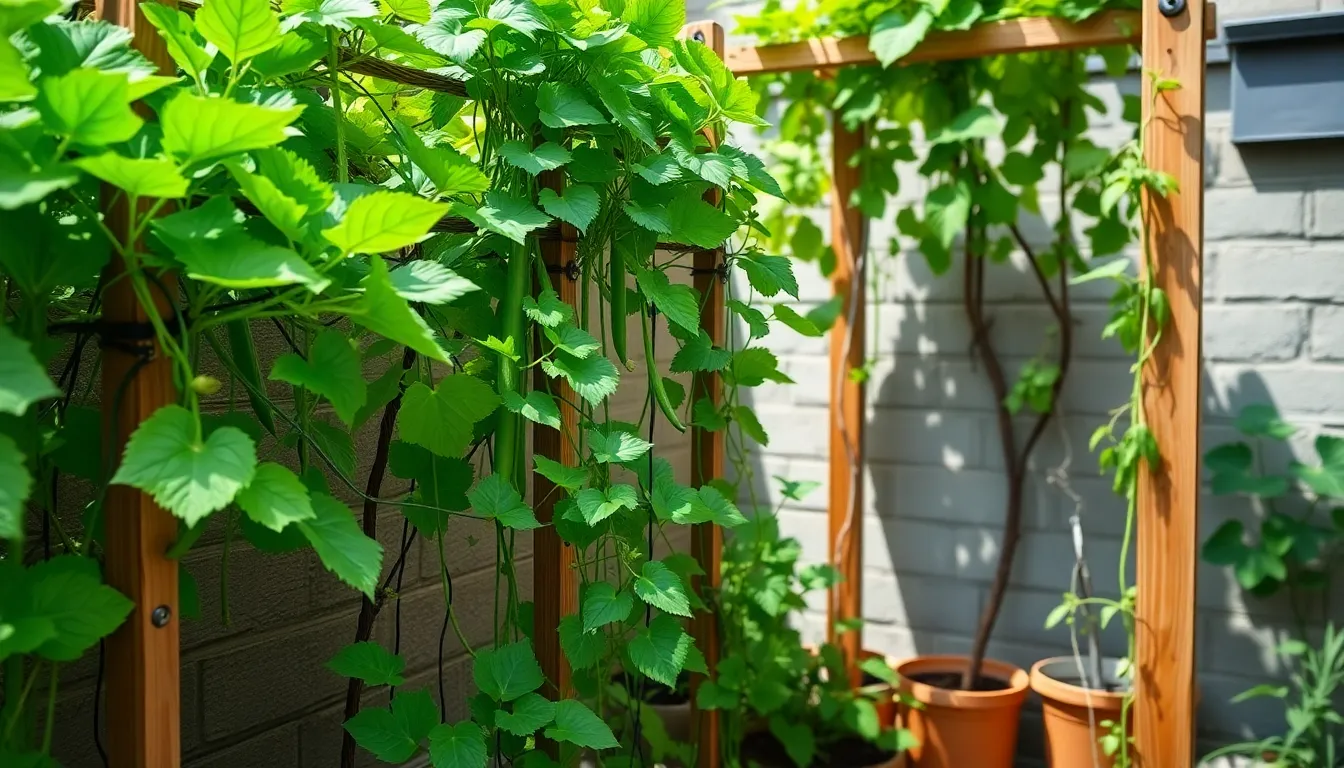
Vertical gardening transforms small spaces into productive growing areas by maximizing plant density and yields without expanding your garden footprint. Climbing vegetables offer an effective solution for urban gardens and limited growing spaces.
Pole Beans for Vertical Growing
Pole beans excel as self-climbing nitrogen fixers that naturally spiral around vertical supports like trellises, bamboo poles, or even sturdy corn stalks. These warm-season plants thrive in full sun and can reach impressive heights of 6 to 10 feet, making them perfect space savers for productive gardens.
Training pole beans requires minimal effort since their vining nature guides them upward with just occasional initial direction. Strong support structures become essential as mature plants and heavy harvests can strain weak frameworks. We recommend installing robust trellises before planting to ensure your vertical bean towers remain stable throughout the growing season.
Peas as Cool-Weather Climbers
Peas serve as ideal early season climbers that tolerate cooler temperatures better than warm-season vegetables. Plant these cool-weather champions in early spring or fall when temperatures remain moderate, allowing you to extend your growing season effectively.
Trellises and netting provide perfect climbing surfaces for pea vines while keeping pods elevated off the ground. This vertical positioning improves air circulation around plants, reducing disease risks that commonly affect ground-level crops. We find that elevated pea growing makes harvesting easier and produces cleaner, healthier pods.
Cucumbers on Trellises
Cucumbers transform into space-efficient climbers when provided with proper vertical support systems like A-frames or sturdy netting. Lifting cucumber vines off the soil prevents common ground-related diseases while promoting better air circulation throughout the plant canopy.
Trellised cucumbers produce straighter, cleaner fruits that require less washing and preparation for kitchen use. This vertical growing method simplifies harvesting since cucumbers hang at eye level rather than hiding beneath sprawling ground vines. We’ve found that trellised cucumber plants often produce higher yields in smaller spaces compared to traditional ground-growing methods.
Cultivate Heat-Loving Warm-Season Crops
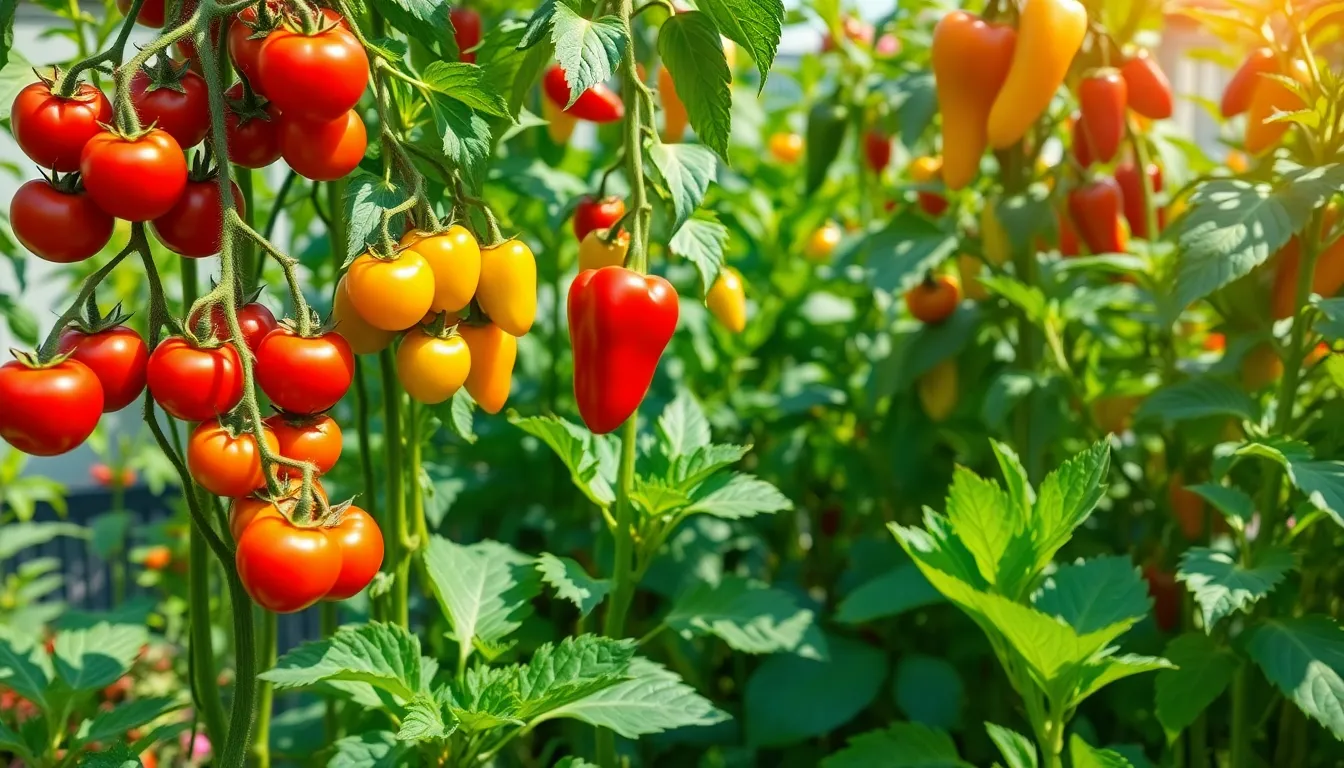
Summer gardening reaches its peak when we embrace vegetables that thrive in scorching temperatures and long sunny days. These warm-season champions transform our gardens into productive powerhouses during the hottest months.
Tomatoes as Garden Centerpieces
Tomatoes stand as the ultimate summer crop and naturally become the focal point of our warm-weather gardens. Cherry tomato varieties offer exceptional disease resistance compared to their larger counterparts, making them ideal choices for gardeners seeking reliable harvests. We need warm soil temperatures and abundant sunlight to achieve optimal growth, as these heat-loving plants refuse to thrive in cool conditions.
Plant spacing becomes crucial when we position tomatoes as centerpieces, allowing adequate air circulation while maximizing our garden’s visual impact. Different varieties provide diverse colors, shapes, and flavors that create stunning displays throughout the growing season.
Peppers for Spice and Color
Peppers bring vibrant hues and varying heat levels to our summer vegetable collections. Sweet bell peppers deliver mild flavors and brilliant colors, while hot pepper varieties range from gently warming to intensely fiery options. Growing conditions mirror those required for tomatoes, though peppers develop more slowly and maintain compact plant sizes.
We can create stunning garden displays by alternating sweet and hot pepper varieties, producing rainbow effects that enhance both visual appeal and culinary diversity. These heat-tolerant plants continue producing throughout the summer months, providing consistent harvests for fresh eating and preservation.
Zucchini for Abundant Harvests
Zucchini produces prolific yields that keep our kitchens supplied throughout the entire warm season. Full sun exposure and well-draining soil conditions create optimal growing environments for these productive summer squash plants. We often find ourselves sharing excess harvests with neighbors due to zucchini’s remarkable productivity.
Single plants can generate multiple fruits weekly once production begins, making zucchini an excellent choice for gardeners seeking maximum returns on their growing space investment. Regular harvesting encourages continued production and prevents fruits from becoming oversized and tough.
Try Unique Herbs to Enhance Your Cooking
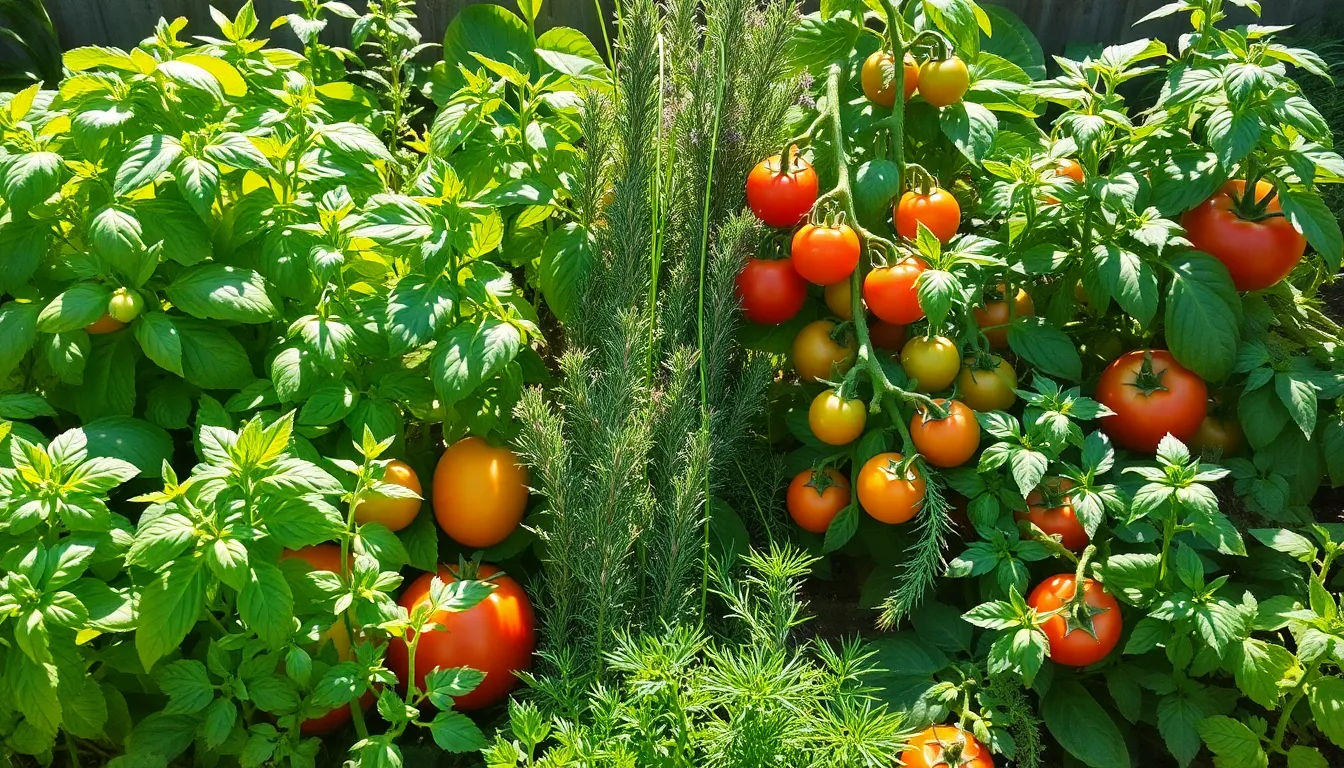
Growing herbs alongside your garden vegetables transforms simple dishes into culinary masterpieces. Fresh herbs pack more flavor than dried alternatives and provide aromatic elements that elevate your homegrown produce.
Basil for Fresh Italian Flavors
Basil brings bright, aromatic notes to Italian-inspired dishes featuring your garden vegetables. We recommend growing lettuce-leaf basil, which produces larger, milder leaves perfect for wrapping grilled zucchini or eggplant from your summer harvest. Sweet basil varieties work exceptionally well in pesto made with your homegrown tomatoes and peppers.
Plant basil after your last frost date when soil temperatures reach 60°F consistently. Space plants 12 inches apart in full sun locations for maximum leaf production. Pinch flower buds regularly to encourage continuous leaf growth throughout the growing season.
Harvest basil leaves in the morning after dew evaporates but before afternoon heat sets in. Cut stems just above leaf pairs to promote bushier growth and extended harvests.
Cilantro for Mexican and Asian Dishes
Cilantro adds fresh, citrusy brightness to dishes featuring your garden’s peppers, tomatoes, and onions. This fast-growing herb complements spicy vegetables and pairs beautifully with lime juice in salsas and Asian stir-fries. We’ve found cilantro particularly effective in cooling down dishes made with hot peppers from your garden.
Sow cilantro seeds directly in cool weather during spring and fall for best results. Plant every 2-3 weeks for continuous harvests since cilantro bolts quickly in warm weather. Choose slow-bolt varieties like ‘Slow Bolt’ or ‘Leisure’ to extend your harvest window.
Cut cilantro stems when plants reach 4-6 inches tall, leaving 2 inches of growth for regeneration. Use scissors to harvest outer leaves first, allowing inner growth to continue producing fresh herbs.
Rosemary as a Perennial Herb
Rosemary provides year-round flavor for roasted vegetables and grilled summer produce from your garden. This hardy perennial herb complements root vegetables like carrots and beets while adding Mediterranean flair to tomato-based dishes. We love using rosemary stems as natural BBQ skewers for grilled vegetables.
Establish rosemary in well-draining soil with full sun exposure for optimal growth. Space plants 24-36 inches apart since mature plants can reach 3-4 feet in height and width. Choose cold-hardy varieties like ‘Arp’ or ‘Hill Hardy’ in northern climates.
Harvest rosemary sprigs throughout the growing season by cutting 4-6 inch stems from actively growing tips. Fresh rosemary maintains its potency better than dried, making it perfect for immediate use with your garden vegetables.
Plant Container-Friendly Vegetables for Small Spaces
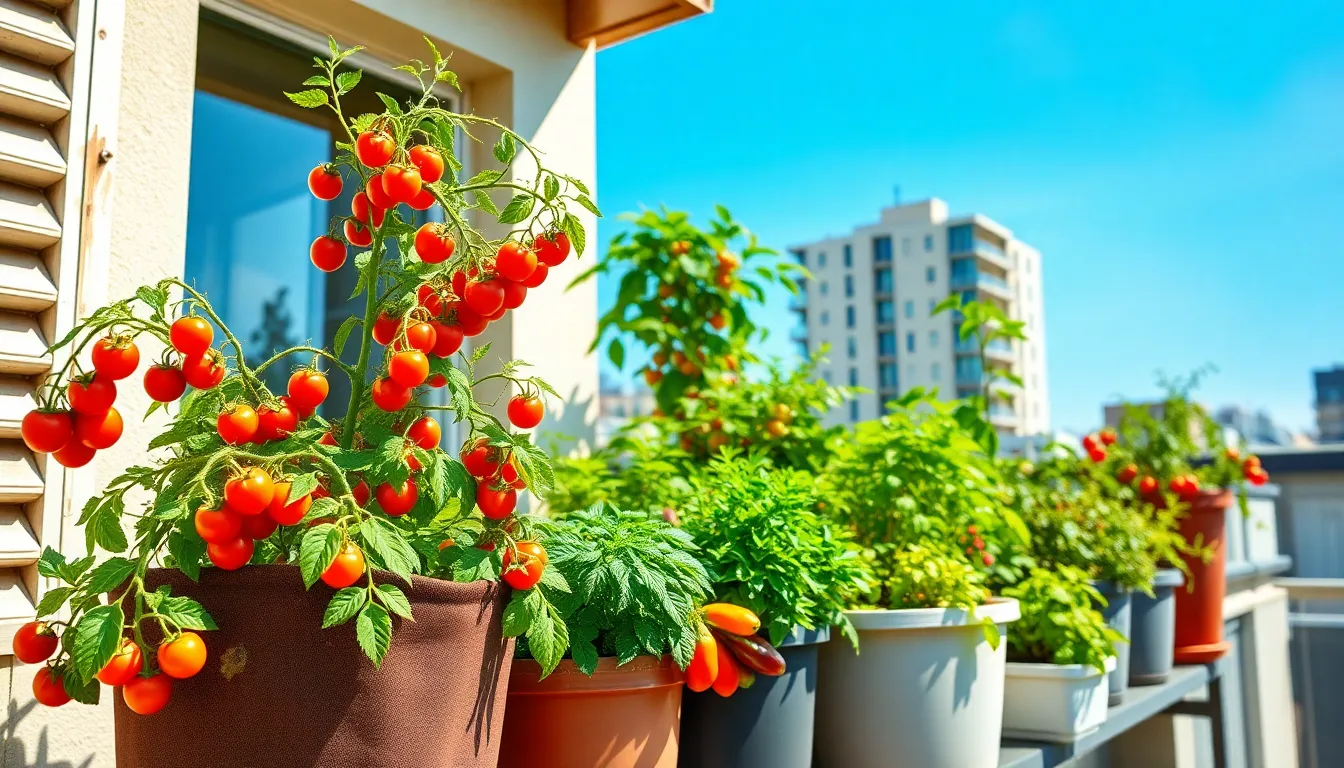
Container gardening opens up endless possibilities for growing fresh vegetables even when space is limited. We can transform balconies, patios, and window sills into productive growing areas that provide abundant harvests throughout the season.
Cherry Tomatoes in Pots
Cherry tomatoes excel in container environments and deliver impressive yields when grown in proper containers. We recommend using 5-gallon fabric grow bags or large plastic and ceramic pots that provide the deep root space these plants need to thrive.
Sturdy containers become essential for supporting cherry tomato plants as they grow tall and heavy with fruit. We’ve found that adequate sunlight exposure combined with proper support structures ensures the most abundant harvests from these prolific producers.
Regular watering maintains consistent soil moisture while well-draining potting mix prevents root rot issues. We suggest adding tomato cages or stakes early in the growing season to support the vigorous growth these container-friendly varieties display.
Herbs in Window Boxes
Window box herb gardens bring fresh flavors directly to our kitchens while requiring minimal space and maintenance. We can grow basil, parsley, thyme, mint, and rosemary in these compact containers for year-round culinary enhancement.
Small pots work perfectly for individual herb plantings when window box space isn’t available. We recommend these herb varieties for beginners because they adapt well to container conditions and provide continuous harvests with proper care.
Fresh herb access transforms our cooking by eliminating trips to the grocery store for expensive packaged herbs. We find that regular harvesting actually encourages more growth and keeps our herb plants productive throughout the growing season.
Dwarf Pepper Varieties
Compact pepper varieties thrive in medium-sized containers ranging from 3 to 5 gallons with proper drainage holes. We can grow these rewarding plants both indoors and outdoors depending on climate conditions and space requirements.
Dwarf pepper plants produce impressive harvests even though their smaller size compared to full-sized varieties. We’ve discovered that these container-adapted peppers respond well to consistent watering schedules and occasional fertilization throughout the growing season.
Drainage becomes crucial for pepper success since waterlogged soil leads to root problems and reduced fruit production. We ensure our containers have adequate drainage holes and use quality potting mix that maintains proper moisture levels without becoming soggy.
Consider Perennial Vegetables for Long-Term Gardens
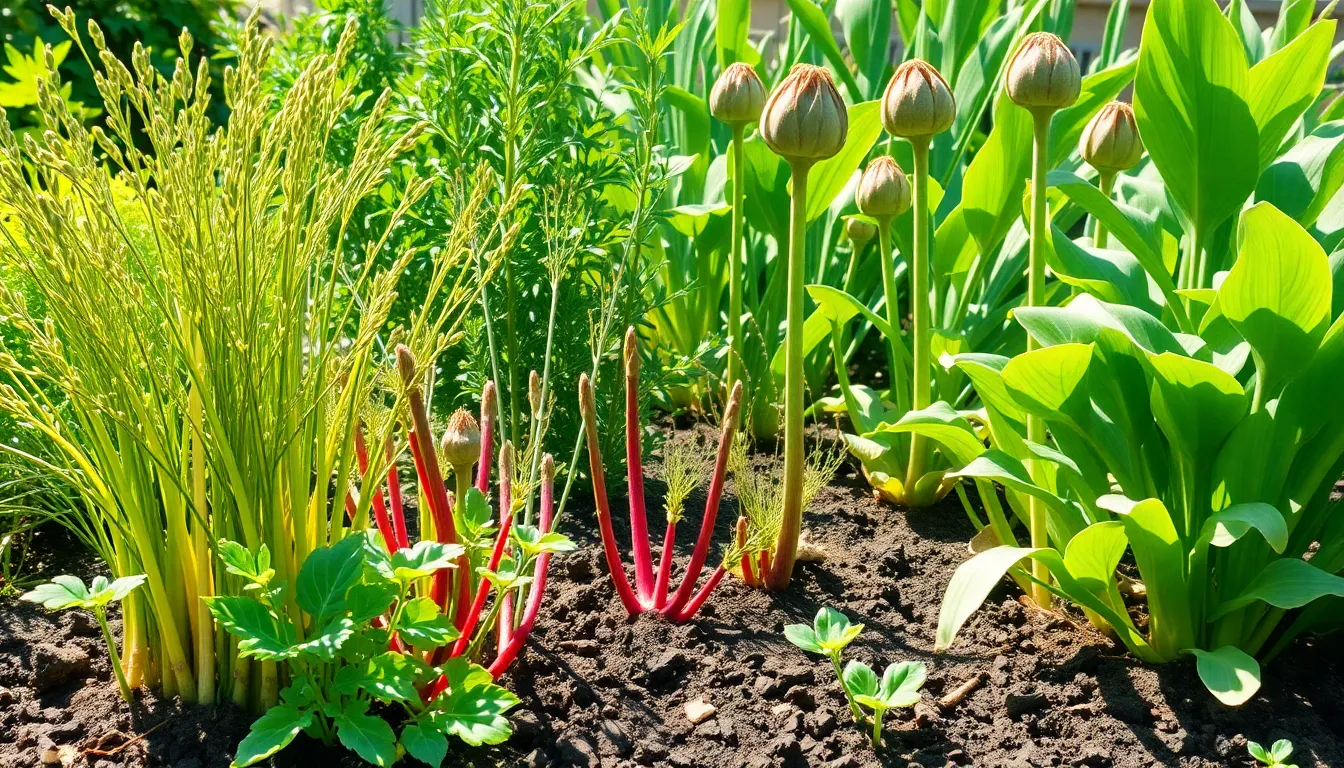
Transitioning from annual container gardens, we can establish a sustainable food system with perennial vegetables that produce for decades without replanting. These hardy plants offer exceptional longevity and require minimal maintenance once established.
Asparagus for Spring Harvests
Asparagus crowns create one of the most rewarding perennial investments for our long-term gardens. We’ll wait approximately three years for the first harvest, but mature plants continue producing spears for 20 to 30 years with proper care. Spring brings tender shoots that emerge from the soil, ready for cutting when they reach 6 to 8 inches tall.
Established asparagus beds demonstrate remarkable resilience through deep root systems that access water and nutrients far below the surface. We can harvest spears for 6 to 8 weeks each spring, cutting them at ground level every few days during peak season. The plants’ extensive root networks improve soil structure and organic matter content year after year.
Rhubarb for Tart Desserts
Rhubarb stalks provide tart flavors perfect for pies, jams, and sauces throughout the growing season. We harvest the thick, colorful stems by pulling them from the base rather than cutting, which encourages continued production. This hardy perennial thrives in cooler climates and tolerates temperatures as low as -40°F.
Mature rhubarb plants spread 3 to 4 feet wide and produce stalks from early spring through fall. We can divide established crowns every 5 to 7 years to create new plants and maintain vigorous growth. The plant’s large leaves decompose naturally, adding organic matter to enhance soil health around the growing area.
Artichokes in Mild Climates
Artichoke plants function as perennials in USDA zones 7 through 11, producing edible flower buds for multiple seasons. We harvest the globe-shaped buds before they open, typically collecting 6 to 10 artichokes per plant during peak production periods. These Mediterranean natives require well-draining soil and full sun exposure for optimal growth.
Established artichoke plants reach 4 to 6 feet in height and width, creating dramatic architectural elements in our perennial vegetable gardens. We can extend the harvest season by cutting side shoots after the main harvest, encouraging secondary bud production. The plants’ deep taproots access moisture during dry periods while improving soil structure through natural aeration.
Plan Succession Planting for Continuous Harvests
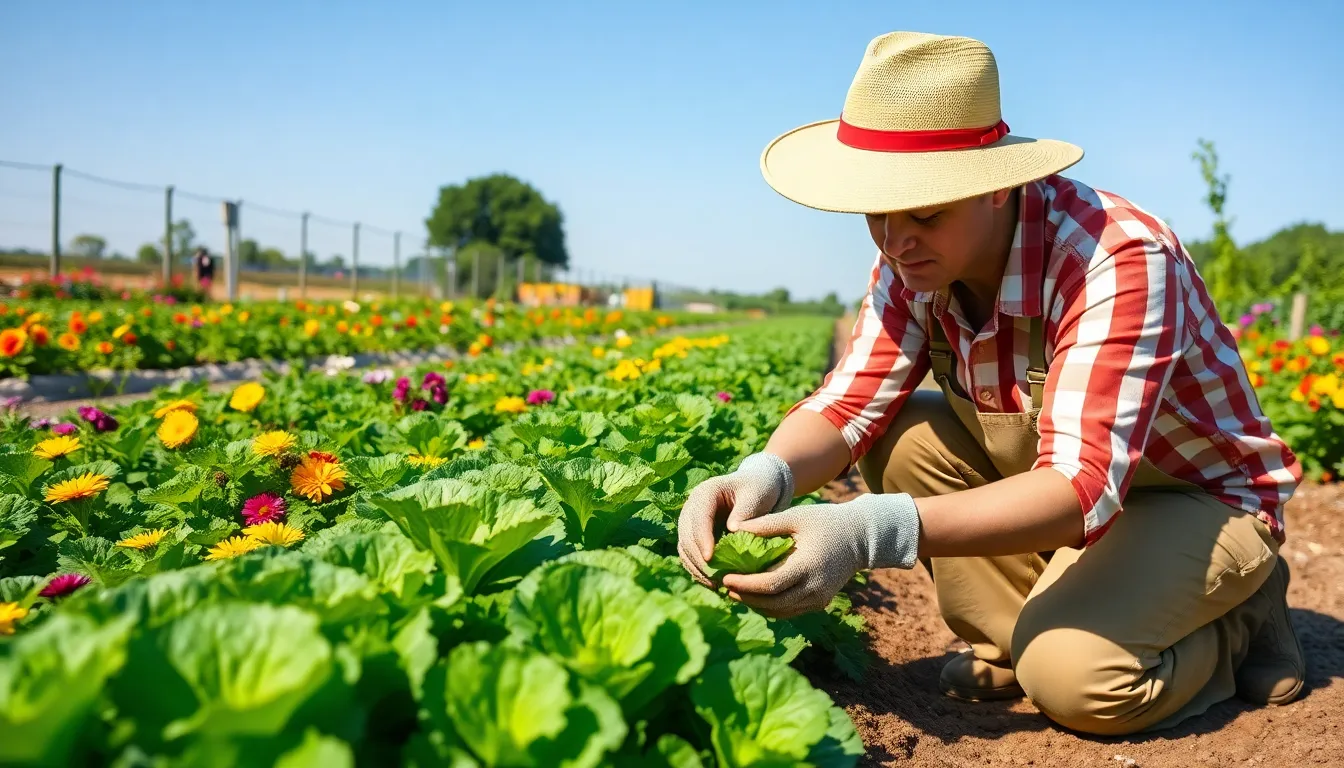
Succession planting transforms your garden into a steady production system by staggering plantings at regular intervals. We’ll plant the same crops every 7 to 14 days throughout the growing season to ensure continuous harvests when previous plantings finish producing.
Staggered Lettuce Sowings
Lettuce provides the perfect foundation for succession planting since it matures quickly and tolerates various growing conditions. We sow new lettuce seeds every 2 to 3 weeks starting in early spring through late summer. Leafy greens like spinach and arugula follow the same planting schedule and complement lettuce perfectly in our garden rotation.
Cool weather varieties thrive in spring and fall while heat tolerant types handle summer conditions. We plant loose leaf varieties first since they’re ready to harvest in just 30 days. Romaine and butterhead varieties take slightly longer but provide different textures and flavors throughout the season.
Small frequent sowings prevent waste since mature lettuce heads decline rapidly in quality. We plant only what our family consumes in 2 to 3 weeks to maintain peak freshness and flavor.
Multiple Bean Plantings
Bush beans excel at succession planting because they mature uniformly within 50 to 60 days of sowing. We plant new bean crops every 2 to 3 weeks from late spring through midsummer for continuous harvests. Fresh plantings replace older ones that finish producing after their initial heavy flush.
Green beans provide steady yields when we harvest pods regularly while they’re tender and crisp. Purple and yellow varieties add color diversity while maintaining the same planting schedule. We stop planting 10 weeks before our first expected frost to ensure the final crop matures completely.
Pole beans require different timing since they produce continuously once established rather than all at once. We plant these climbing varieties once per season but succession plant bush types for extended harvests.
Sequential Radish Crops
Radishes mature fastest among root vegetables at just 25 to 30 days from seed to harvest. We sow radish seeds every 1 to 2 weeks throughout cool seasons for the most efficient succession schedule. Spring plantings begin 4 weeks before our last frost while fall sowings continue until 4 weeks before hard freeze.
Quick maturation means we can squeeze radish crops between slower growing vegetables like carrots and beets. We interplant radishes with carrots since radishes harvest before carrots need the full space. This companion planting maximizes our garden’s productivity per square foot.
Different radish varieties provide options for various seasons and uses. Cherry Belle and French Breakfast varieties work well for spring succession while Daikon types prefer fall plantings. We choose varieties based on our climate timing and intended harvest schedule.
Conclusion
Growing your own vegetables transforms both your kitchen and your wallet while connecting you to the satisfaction of homegrown food. Whether you’re working with a sprawling backyard or a tiny balcony we’ve shown you that fresh produce is within reach through strategic planning and smart gardening techniques.
From quick-growing leafy greens to space-saving vertical gardens and long-term perennial investments there’s a vegetable gardening approach that fits your lifestyle and space constraints. The key lies in starting small choosing varieties suited to your conditions and gradually expanding as your confidence grows.
Your garden doesn’t need to be perfect from day one. Each season brings new opportunities to try different vegetables refine your techniques and discover what works best in your unique growing environment.
Frequently Asked Questions
What are the easiest vegetables for beginner gardeners to grow?
Leafy greens like lettuce, spinach, and kale are perfect for beginners. They grow quickly, require minimal space, and are relatively low-maintenance. Radishes are also excellent starter vegetables, ready to harvest in just 21-30 days. These crops are forgiving and provide quick success to build gardening confidence.
How can I grow vegetables if I only have a small space?
Vertical gardening and container gardening are excellent solutions for small spaces. Use trellises for climbing plants like pole beans, peas, and cucumbers. Grow cherry tomatoes, herbs, and dwarf peppers in containers on balconies or patios. Window boxes work perfectly for herbs like basil, parsley, and thyme.
What is succession planting and how does it work?
Succession planting involves sowing crops at regular intervals to ensure continuous harvests. Plant lettuce every 2-3 weeks from early spring through late summer. Similarly, stagger plantings of bush beans, radishes, and other leafy greens. This technique maximizes garden productivity and provides fresh produce throughout the growing season.
Which vegetables are best for vertical gardening?
Pole beans, peas, and cucumbers are ideal for vertical gardening. Pole beans can reach 6-10 feet and fix nitrogen in soil. Peas thrive in cool weather and benefit from trellis support. Cucumbers become more productive when grown vertically, with better air circulation and easier harvesting.
What are the benefits of growing perennial vegetables?
Perennial vegetables like asparagus, rhubarb, and artichokes provide long-term returns with minimal annual effort. Asparagus produces for 20-30 years after establishment, while rhubarb offers tart stalks perfect for desserts. These plants improve soil health and provide continuous harvests year after year.
How do I maximize my garden’s productivity in summer?
Focus on warm-season crops like tomatoes, peppers, and zucchini that thrive in summer heat. Ensure proper plant spacing for air circulation, provide adequate water, and harvest regularly to maintain production. Zucchini can produce multiple fruits weekly when harvested consistently.
What herbs should I grow for cooking?
Start with basil for Italian dishes, cilantro for spicy cuisine, and rosemary for roasted vegetables. Lettuce-leaf basil offers larger leaves, while cilantro grows quickly and can be succession planted. Rosemary is a hardy perennial that provides year-round flavor enhancement.
How do I prepare soil for root vegetables like carrots?
Root vegetables need loose, well-draining soil free of rocks and debris. Work compost into the soil to improve texture and fertility. For carrots specifically, ensure soil is worked to at least 12 inches deep to accommodate their growth. Proper soil preparation is crucial for straight, healthy root development.

